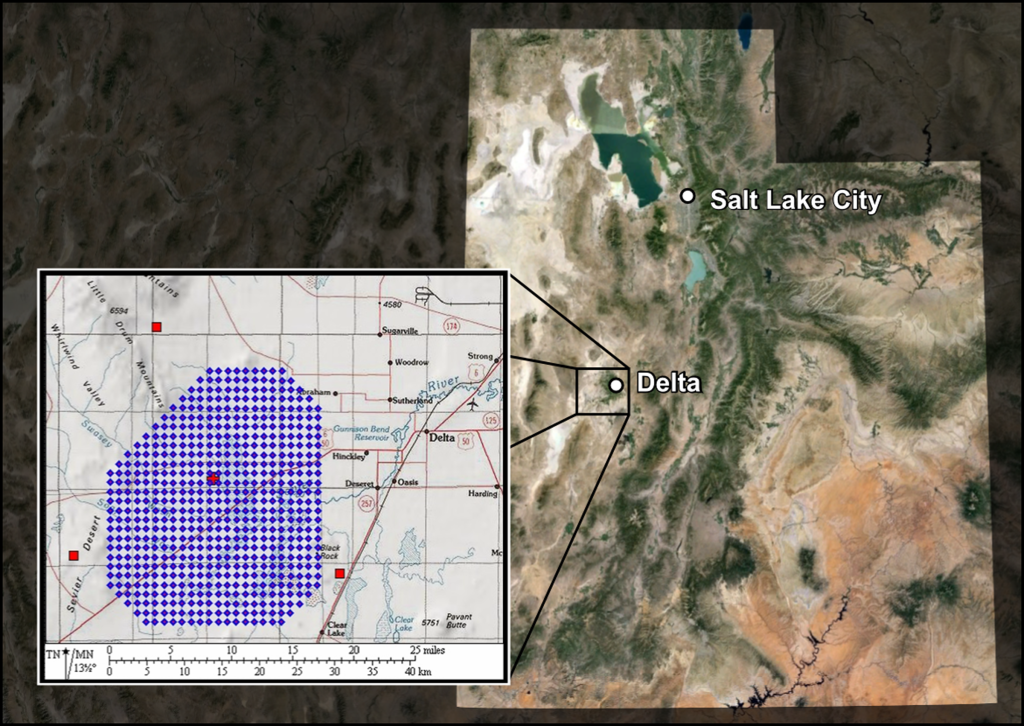
Citizen Science No. 11 by Jamie Zvirzdin
Desert Vigil: Patience and the Pulse of Cosmic-Ray Secrets
I am not a patient person, usually. I check the time frequently and grow frustrated if a task takes more than two seconds to finish. The exception is my job: I work for the Telescope Array Collaboration, which studies ultrahigh-energy cosmic rays. Tracking these types of rare particles in the high, dry desert of Utah requires a superhuman amount of patience, dedication, and collaboration.
Once in a while, this patient sleuthing yields a gratifying breakthrough. Last week, Thanksgiving 2023, the Telescope Array Collaboration announced the detection of a UHECR named Amaterasu (https://scienmag.com/telescope-array-detects-second-highest-energy-cosmic-ray-ever/), which had 244 exaelectronvolts of energy—about 40 joules, enough energy to run a modern laptop for a few seconds or raise a small book to the top of a tall shelf. While 40 joules may not seem like a big deal, it’s an enormous, astonishing, brain-shattering amount of energy for a tiny particle. Amaterasu had so much energy that it broke what you might call “the particle speed limit,” the Greisen-Zatsepin-Kuzmin cutoff, at around 60 EeV (about 10 joules).
Amaterasu’s energy is superseded by only one other particle. In 1991, the Fly’s Eye detector—the earliest iteration of the Telescope Array, also based in the Utah desert—recorded the Oh-My-God particle, a cosmic ray with 320 EeV or about 50 joules of energy. How do such itty-bitty pieces of matter gain so much energy? Where do they come from?
Here’s the hard answer: We still don’t know for sure, and it is better to be thorough and follow the scientific method than to willy-nilly claim something without evidence. In fact, Amaterasu’s arrival has caused even more questions: Even accounting for differences in mass and changes in direction caused by magnetic fields, our data shows that Amaterasu came to us from the Local Void, an area of space beyond the Milky Way Galaxy. How could something in an empty part of space give Amaterasu so much energy?
Here are the leading contenders of where these ultrahigh-energy cosmic rays might come from:
- Active Galactic Nuclei: AGNs are the violent regions at the centers of some galaxies, often surrounding supermassive black holes. But Amaterasu’s energy level and arrival direction don’t directly align with any known AGNs near the Local Void.
- Starburst Galaxies: Galaxies that form stars rapidly can accelerate particles to very high energies, but again, Amaterasu’s arrival direction doesn’t exactly match what we currently know about starburst galaxies in the Local Void.
- Gamma-Ray Bursts: When massive stars collapse or neutron stars emerge in distant galaxies, these extremely energetic explosions have enough power to produce high-energy cosmic rays, but their sporadic, fleeting nature makes it hard to correlate them with Amaterasu’s arrival time and direction.
- Unknown Physics: There’s plenty of room for speculation, given how much we still don’t understand about our universe. Magnetars? Merging AGNs? Shockwaves from galaxy clusters? Dark matter annihilation? It will take more patience to unravel this mystery.
We especially need patience because ultrahigh-energy cosmic rays are much harder to track than the lower-energy ones our sun flings at us all the time. On average, only one UHECR strikes one square kilometer per century. To track as many as we can, the Telescope Array has set up cosmic-ray detectors across the west desert of Utah, covering about 700 square kilometers. Across this space, which is about the size of Rhode Island, we run fluorescence detectors on moonless nights and fix scintillation detectors on hot desert days. We calibrate, program, analyze, teach, wait and work for that captured spike in our data so we can trace the footprints of these elusive visitors back to their extragalactic sources, whatever they may be.
I’ve been hooked on the mystery of UHECRs since I was a 16-year-old intern researching cosmic rays at the University of Utah. If I could wish upon a Void, I’d wish for more people to turn from war and conflict back to these universal mysteries. Beat weapons into scintillation detectors, beat anger into patience, beat fear into curiosity. The greatest human triumphs come not from conquests but from the collective pursuit of understanding the universe we share.
This newest UHECR was named after a pivotal goddess in Japanese mythology. Amaterasu was the goddess of the sun, the queen of the kami (spirits), the ruler of the universe. After her brother Susanoo, god of the sea and storms, went on a destructive rampage across the land, Amaterasu hid herself in a cave, casting the world into darkness, unease—chaos. Other gods, hoping to coax her out of the void, held a noisy celebration. Curious, Amaterasu left the cave and brought light out of darkness. Just as Amaterasu’s emergence dispelled the darkness, the discovery of this cosmic ray lights up new paths in the quest to understand our universe.
As the days in the Northern Hemisphere grow darker this season, there is a small upside to the extended darkness: Our Telescope Array night shifts are longer, so our chances to catch more cosmic rays like Amaterasu are higher. Working to find these rare cosmic messengers, like all scientific quests, is all about nurturing curiosity, tolerating uncertainties, and celebrating the slow unraveling of bright universal secrets. If you get the chance, look into the sky toward the Local Void, in the direction of the constellation Hercules, and celebrate with us the bright arrival of Amaterasu.
Jamie Zvirzdin researches cosmic rays with the Telescope Array Project, teaches science writing at Johns Hopkins University and is the author of “Subatomic Writing.”

